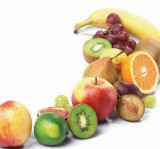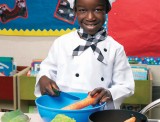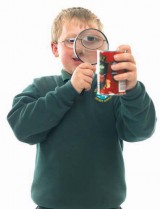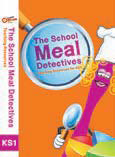The School Food Trust serves up two tasty lessons stuffed with a healthy, cross curricular filling...
 Hark back to the days of soggy semolina…
Hark back to the days of soggy semolina…
• Show the class two photographs of children eating in a school dining hall: one from the 1900s and one from the present. Ask pupils to compare and contrast the two images – what do they think the children are eating? Why might all the meals be the same? Is the food hot or cold?
• Explain that in the past, the health of many children in England was poor; some people had very little money and lacked a healthy balanced diet. These children often went hungry and so lacked energy. School meals were provided as a charitable act from the mid-nineteenth century and expanded after the 1870 Education Act, amid rising concerns about undernourished children.
• Tell the class that in the early 1900s all food had to be fresh as there were no fridges. All cooking was done on coal fires. What do we use today? How do we store fresh food? In the past people did not enjoy the same variety of foods as we do today. Children ate what they were given, often the same thing every day. Look closely at the food. What was the food choice in Victorian times?
• Discuss the social aspect of staying in school to eat lunch with friends. Why might this be an important part of the day?
• Listen to this radio extract of children discussing school meals 40 years ago (http://www.bbc.co.uk/schoolradio/history/britainsincethe1930s_clip33.shtml). Even though the children enjoyed eating school meals with their peers, they had less choice of food. What did the children want to see on the menu? What does it tell us about the food offered 40 years go? Who has eaten those foods at school? What is the choice like today?
 Decorate your food hall with healthy messages…
Decorate your food hall with healthy messages…
Year 1
Explain what bunting is to the children. It was used in the past and is still used today during celebrations and to mark special occasions. Give children a triangle of material and fabric pens to draw themselves and their friends eating school dinners, adding a key message on the back about why it is important to eat a healthy balanced meal at lunch.
Year 2
Ask children to draw a picture of their dining hall, the food, catering staff and children. This should then be labelled with particular attention to the food. Can they reference food to the ‘eatwell plate’ and include each section of the food plate on their drawing to show that a variety of choice helps us to eat a balanced diet? When children have finished, display the bunting from Y1 and class pictures from Y2 around the dining hall.
How much information have the children digested?
• Set up a hot seating activity in which a members of the class are asked questions about school meals today. Why do they have school meals? What do they like about the various foods? Why is lunch a good time to catch up with friends? What do they think a school meal gives them that helps them to work for the rest of the day?
• Finish by asking: what have we learnt about school meals today? Why might they be an important element of the school day?
And for homework…
What were school meals like for children’s parents/carers/grandparents when they were at school? What was the dining hall like? How did they sit? Where did they have to go to get the food? Can children find any photos of their family enjoying lunch at school and/or home? How was lunchtime the same/different? How have school meals improved today?
 Where does it all come from?
Where does it all come from?
Ask children to name some of the different places that our food comes from. Use a world map to show/point to them. Why do we import/export food (e.g. climate, costs of farming, changing tastes)? Show a video about food grown in another country that is transported to UK supermarkets. Fairtrade’s website has useful and interesting clips: http://www.fairtrade.org.uk/resources/films/default.aspx
• Now look at your school menu and using a world map, ask what foods children can name and where they might come from? Brainstorm ideas in small, mixed groups.
• Hand out magnifying glasses and food labels from school caterers. Let the children search for clues from the labels, stickers and logos.
• Ask children to place pins on the world map to show where these items come from and then repeat this exercise using food labels brought from home. This can form the basis of a classroom display.
• Hand out atlases; recap on how they can be used to find out where different foods are produced.
• Ask the children to draw/write about where the different food items have come from in groups. They could stick labels on a group poster and annotate it as part of the classroom display. Each group could then report their findings to the class.
Discuss locally vs. globally sourced food…
Talk about the global affects of transporting food from around the world. Introduce the term ‘sustainability’. How does food from other countries compare with the foods grown here? How might following seasonal variations in home grown products have a positive effect on the environment? Upper KS2 children could research this first and then report to the class.
Extension activities
• Children could investigate the benefits of buying/eating foods grown in the UK.
• Discuss the effects on consumers of importing food and start understanding the benefits of buying local produce, reducing carbon footprint etc.
• The Sustainable Table website explains the benefits of buying local produce and covers many sustainability issues. http://www.sustainabletable.org/issues/eatlocal Children could investigate foods in their local supermarket. Which foods are imported and why? Interview the supermarket manager to find out why certain foods are imported and how much of their produce is sourced locally. You could even invite the manager to the school.
 If you liked the activities in this article, you’ll find more of the same in the School Food Trust’s new resource The School Meal Detectives. You can get hold of this teaching pack for free by signing up to the Trust’s Million Meals campaign at http://www.schoolfoodtrust.org.uk/millionmeals. By joining you’ll receive guidance and be given access to other free tools that will help you to increase school meal take up.
If you liked the activities in this article, you’ll find more of the same in the School Food Trust’s new resource The School Meal Detectives. You can get hold of this teaching pack for free by signing up to the Trust’s Million Meals campaign at http://www.schoolfoodtrust.org.uk/millionmeals. By joining you’ll receive guidance and be given access to other free tools that will help you to increase school meal take up.
Easy ways to combat teacher stress
Ace-Heads
Teaching Mandarin via video conference
Languages
